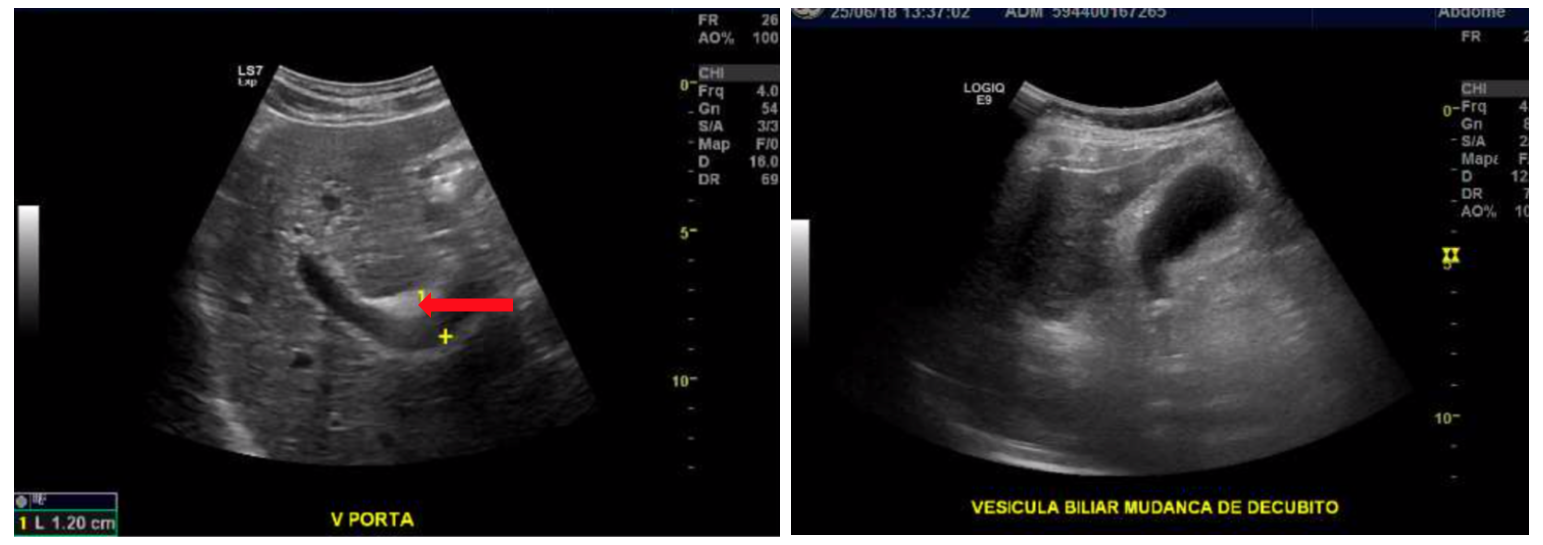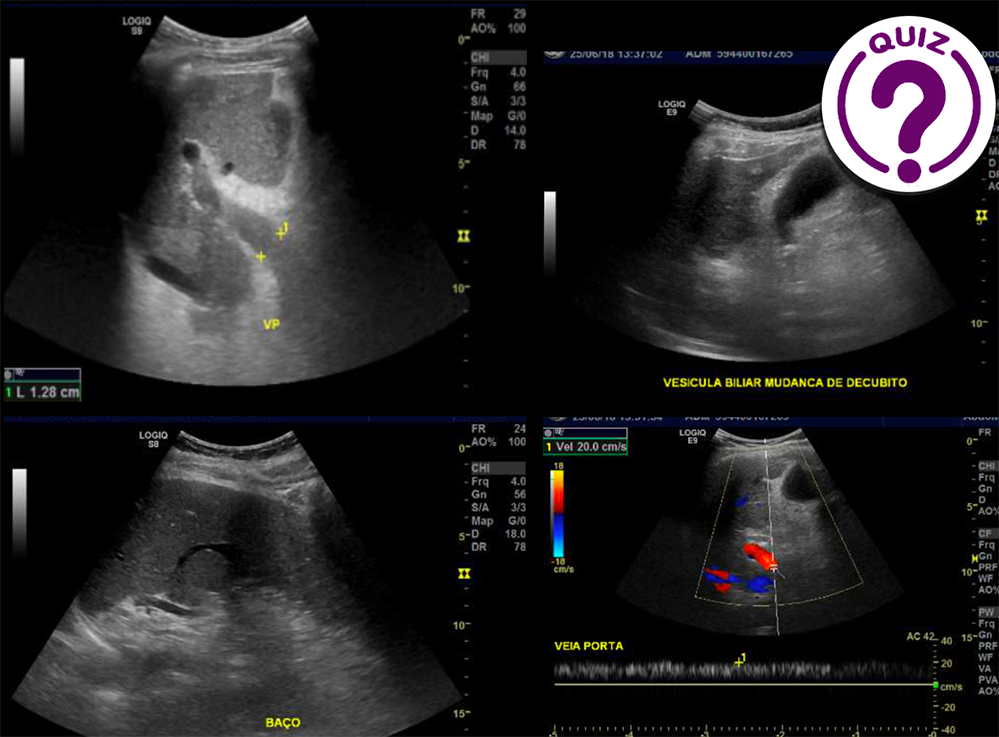Webinar: Ultrasound in COVID-19 – global experience
May 11, 2020Peru WFUMB COE
July 1, 2020Liver Red Flags
Eduardo Davino Chiovatto1
Alessandra Rodrigues Silva Chiovatto1
Marcelo Violi Schelini1
Fernando Linhares Pereira1, 2
Julia Diva Zavaris1, 2
Maria Cristina Chammas1, 2
Wagner Iared1, 3
1.) Ultrasonography Improvement and Research Center Prof. Dr. Giovanni Guido Cerri, DASA, São Paulo, Brazil.
2.) Institue of Radiology, Hospital das Clinicas School of Medicine, University of São Paulo, São Paulo, Brazil
3.) Department of Medicine – Federal University of São Paulo, São Paulo, Brazil.
Clinical History:
A 68-year-old female from the countryside of São Paulo was referred to our clinic for a routine ultrasound examination. She had diabetes and arterial hypertension and no history of hepatitis, alcoholism or AIDS.

Quiz-summary
0 of 1 questions completed
Questions:
- 1
Information
View the June Case below, answer the question and then click check >
You have already completed the quiz before. Hence you can not start it again.
Quiz is loading...
You must sign in or sign up to start the quiz.
You have to finish following quiz, to start this quiz:
Results
0 of 1 questions answered correctly
Your time:
Time has elapsed
You have reached 0 of 0 points, (0)
Categories
- Not categorized 0%
- 1
- Answered
- Review
-
Question 1 of 1
1. Question
Question: In this case, the main signs and probable diagnosis are:
Correct
CORRECT ANSWER EXPLAINED BELOW Correct answer is:
Thick and echogenic bands surrounding the portal vessels and gallbladder. – Schistosomiasis (hepatosplenic form)

Explanation:
Schistosomiasis is an important health problem in underdeveloped countries, especially in South America. The case represents a hepatosplenic form of this disease. The main findings in this presentation are thick and echogenic bands around the portal vessels and the gallbladder. Splenomegaly is highly prevalent in these patients, often with siderotic nodules. The rate of blood flow in the portal vein is usually normal (>16 cm/s) in the early stages of the disease.
In cirrhosis the main signs are nodulated liver surface, parenchymal disorganization, caudate lobe hypertrophy and portal hypertension with low blood flow speeds in the portal vein, typically <15 cm/s.1,2,3
Take home message:
Although ultrasound findings must be associated with epidemiologic information for best accuracy, in a liver marked by periportal thickening, especially if associated with pronounced splenomegaly, schistosomiasis must be remembered in the differential diagnoses of liver diseases. Special attention must be taken to the thick and echogenic bands surrounding the portal vessels and the gallbladder.
References
- Azevedo, LM; Queroz LC; Santo, MCCE; Chammas, MC. Aspectos ultrassonográficos e hemodinâmicos da esquitossomose mansônica: avaliação pela ultrassonografia Doppler em áreas endêmicas. Radiologia Brasileira, vol.43 nº2-Mar/Abr 2010
- Hatz C, Jenkins JM, Ali QM, Abdel- Wahab MF, Cerri GG, Tanner M. A review of the literature on the use of ultrasonography in schistosomiasis with special reference to its use in field studies. 2. Schistosoma mansoni. Acta Trop 1992;51:15¾28CH, Dickman K, Tisch DJ. Reassessment of the cost of chronic helmintic infection: a meta-analysis of disability-related outcomes in endemic schistosomiasis. Lancet 2005; 365:1561.
- Meurs L, Mbow M, Vereecken K, et al. Epidemiology of mixed Schistosoma mansoni and Schistosoma haematobium infections in northern Senegal. Int J Parasitol 2012; 42:305.
Incorrect
CORRECT ANSWER EXPLAINED BELOW Correct answer is:
Thick and echogenic bands surrounding the portal vessels and gallbladder. – Schistosomiasis (hepatosplenic form)

Explanation:
Schistosomiasis is an important health problem in underdeveloped countries, especially in South America. The case represents a hepatosplenic form of this disease. The main findings in this presentation are thick and echogenic bands around the portal vessels and the gallbladder. Splenomegaly is highly prevalent in these patients, often with siderotic nodules. The rate of blood flow in the portal vein is usually normal (>16 cm/s) in the early stages of the disease.
In cirrhosis the main signs are nodulated liver surface, parenchymal disorganization, caudate lobe hypertrophy and portal hypertension with low blood flow speeds in the portal vein, typically <15 cm/s.1,2,3
Take home message:
Although ultrasound findings must be associated with epidemiologic information for best accuracy, in a liver marked by periportal thickening, especially if associated with pronounced splenomegaly, schistosomiasis must be remembered in the differential diagnoses of liver diseases. Special attention must be taken to the thick and echogenic bands surrounding the portal vessels and the gallbladder.
References
- Azevedo, LM; Queroz LC; Santo, MCCE; Chammas, MC. Aspectos ultrassonográficos e hemodinâmicos da esquitossomose mansônica: avaliação pela ultrassonografia Doppler em áreas endêmicas. Radiologia Brasileira, vol.43 nº2-Mar/Abr 2010
- Hatz C, Jenkins JM, Ali QM, Abdel- Wahab MF, Cerri GG, Tanner M. A review of the literature on the use of ultrasonography in schistosomiasis with special reference to its use in field studies. 2. Schistosoma mansoni. Acta Trop 1992;51:15¾28CH, Dickman K, Tisch DJ. Reassessment of the cost of chronic helmintic infection: a meta-analysis of disability-related outcomes in endemic schistosomiasis. Lancet 2005; 365:1561.
- Meurs L, Mbow M, Vereecken K, et al. Epidemiology of mixed Schistosoma mansoni and Schistosoma haematobium infections in northern Senegal. Int J Parasitol 2012; 42:305.

